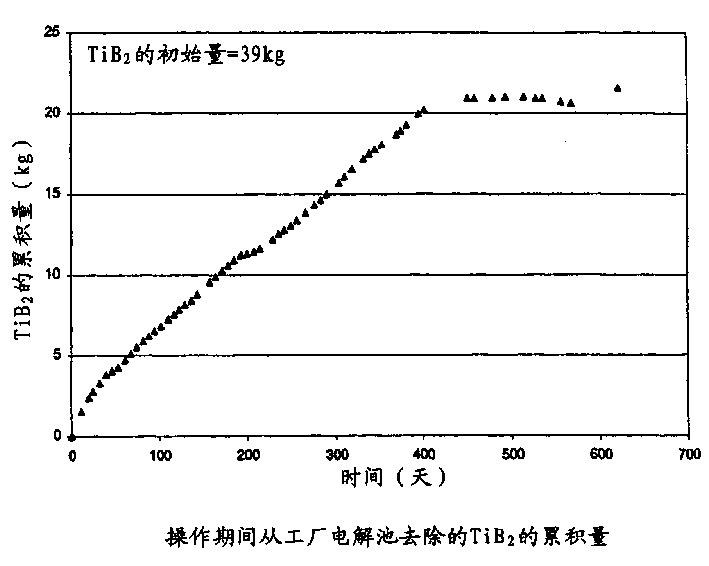A method for providing a protective coating for carbonaceous components of an electrolysis cell
A technology of electrolytic cells and carbon components, applied in the direction of electrolytic components, electrolytic processes, electrodes, etc., to achieve the effect of reducing net carbon consumption
- Summary
- Abstract
- Description
- Claims
- Application Information
AI Technical Summary
Problems solved by technology
Method used
Image
Examples
Embodiment 1
[0037] By mixing 30 wt% H 3 BO 3 , 30 wt% AlF 3 and 40% by weight ammonium lignosulfonate to prepare a suspension. Lignosulfonate was obtained as a 50% liquid formulation from Borregaard Lignotech, Bridgewater, NJ (NORLIG TSFL TM ). In the liquid state, the lignosulfonate has a pH range of 4-5 and contains 47.5-51.5% solids. h 3 BO 3 and AlF 3 is in powder form.
[0038] Spray the suspension on the upper part of the pre-baked anode to about 1 / 2 to 1 / 3 height of the anode using a spray gun with a pressure of 120 psi.
Embodiment 2
[0040] A series of oxidation experiments were performed using small laboratory-grade samples of anode material coated with various coating formulations having lignosulfonate as the primary binder. NORLIG TSFL TM Used again as described in Example 1. Use a spray gun with 120psi pressure to apply the paint to a thickness of about 2mm, then let it air dry at room temperature for about 3 hours.
[0041] In the oxidation experiments, the coated samples were exposed to high temperatures in a 13" x 7" x 10" furnace. The furnace was heated from room temperature to 600°C in 4 hours and held at 600°C for 12 hours.
[0042] Each sample was weighed before and after exposure, and the percent weight loss was calculated. The composition of the coatings and the results obtained are listed in Table 1 below:
[0043] Sample serial number
composition
oxidation
(% weight loss)
Solid content
LSA **
(%)
Phenolic resin
fat
B ...
Embodiment 3
[0047] The procedure of Example 2 was repeated using other various coating compositions. The composition of the coatings used and the oxidation results obtained are listed in Table 2 below:
[0048] Sample serial number
composition
oxidation
(% weight loss)
Solid content
LSA **
(%)
Phenolic resin
fat
B 2 o 3
(%)
h 3 BO 3
(%)
Additives
(%)
Comparative Experiment
0
0
0
0
60-90
E-60
40
1
57
2 SiC
7
E-61
40
1
57
2 SiC
1
E-62 *
40
1
57
2 SiO 2
1
E-63 *
40
1
57
2 SiO 2
2
E-78
40
-
30
30 AlF 3
0
E-79
40
-
30
30 AlF 3
0
E-80
40
2
...
PUM
| Property | Measurement | Unit |
|---|---|---|
| thickness | aaaaa | aaaaa |
| thickness | aaaaa | aaaaa |
| thickness | aaaaa | aaaaa |
Abstract
Description
Claims
Application Information
 Login to View More
Login to View More - R&D
- Intellectual Property
- Life Sciences
- Materials
- Tech Scout
- Unparalleled Data Quality
- Higher Quality Content
- 60% Fewer Hallucinations
Browse by: Latest US Patents, China's latest patents, Technical Efficacy Thesaurus, Application Domain, Technology Topic, Popular Technical Reports.
© 2025 PatSnap. All rights reserved.Legal|Privacy policy|Modern Slavery Act Transparency Statement|Sitemap|About US| Contact US: help@patsnap.com


